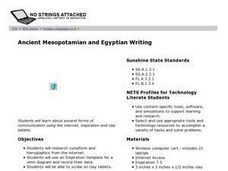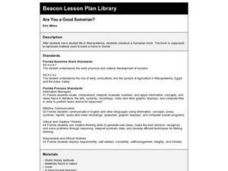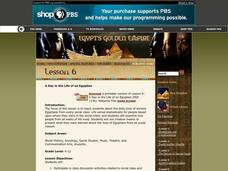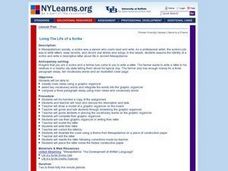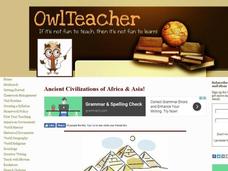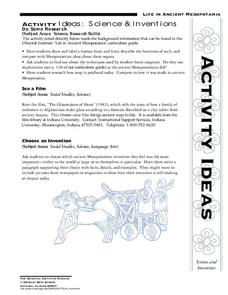Curated OER
How to "Read" an Artifact
Students discuss the types of information they can get from artifacts. In groups, they practice "reading" artifacts and determining their usage. They use inferences to test against official information about certain pieces. They also...
Curated OER
Ancient Mesopotamia
For this geography worksheet, students read about ancient Mesopotamia and respond to five short answer questions that follow. They identify what part of the country was the heart of Mesopotamia. Then students compare the given map with a...
Curated OER
Bank On It! Ancient Farming
In this ancient farming worksheet, students fill in the blanks in 25 sentences about farming in Mesopotamia. Students will use the words in a word bank. Prior knowledge or research will be needed.
Curated OER
Ancient Civilizations: Mesopotamia
Students read about the ancient civilization of Mesopotamia. They investigate the art, culture, and history, and read an overview about the gods and goddesses.
Curated OER
Comparing and Contrasting Three Civilizations
Sixth graders compare and contrast ancient civilizations. In this research skills lesson, 6th graders use SMART Board programs to compare and contrast the economies, cultures, and geography of Mesopotamia, Egypt, and India.
Curated OER
Ancient Mesopotamian and Egyptian Writing
Students research cuneiform and hieroglyphics from the internet and use educational software to create their own cuneiform tablet in this excellent World History lesson plan. The use of the computer software program Inspiration 7.5 is...
Curated OER
Mesopotamian Gods and Goddesses
Each of the Mesopotamian Gods and Goddesses are associated with a city and a symbol. This hand out is intended as a quick reference guide to help learners recall 12 of the most prominent of these figures.
Curated OER
The Mesopotamian Peoples
In this online interactive world history worksheet, high schoolers answer 12 multiple choice questions regarding Mesopotamia. Students may submit their answers to be scored.
Curated OER
Mesopotamian Gods: Handout
Ancient religion was often times closely linked to social structure and government. Hand out a handy guide that describes 12 major gods and goddesses from ancient Mesopotamia. They are each connected to a location, symbol, and force of...
Curated OER
Interpreting the Evidence
Students find out about the social changes that caused the collapse of important ancient civilizations in Central America, Mesopotamia, the southwestern United States, and western Africa.
Time Warp Trio
The Seven Blunders of the World
Learners explore the cultures and civilizations of Mesopotamia. They take a look at the factors that shaped the region, and study the history of the Hanging Gardens of Babylon, and other ancient wonders of the world. The class is divided...
Curated OER
Are You a Good Sumerian?
Studetns, after studying life in Mesopotamia, create a Sumerian brick.
Curated OER
A Day in the Life of an Egyptian
Students study the daily lives of ancient Egyptians from every social class. They use creative means to present what they have learned about the lives of Egyptians from all social classes.
Curated OER
World History Fall Final: Ancient History to the American Revolution
A variety of topics and activities make up this presentation, which prompts viewers to answer questions from the Stone Age to the American Revolution. Note: You may find some slides more useful and pertinent than others.
Curated OER
Living The Life of a Scribe
Students write a descriptive letter about life in ancient Mesopotamia. Through video streaming, students discover the history of Mesopotamia. They assume the role of a scribe and compose a three paragraph essay using main ideas and...
Owl Teacher
Teach Ancient Civilizations: Africa
Amazing! Teach learners about the wonders of ancient Africa and Asia with a comprehensive set of teaching tools. You'll click to find a well-constructed presentation, a worksheet that has kids compare and contrast ancient alphabets, a...
Curated OER
Natural Resources and Ancient Cities
Students explain how the availability of natural resources has affected human settlement patterns. They recognize the interactions of human populations on environments and compare the growth of two ancient cities in relation to natural...
Curated OER
Ancient Civilizations: The Ancient Israelites
Planning a study of ancient Israel and Mesopotamia (1800-500 B.C.)? Here's a resource packet loaded with activities, exercises, worksheets, and background information that integrates social studies and language arts curriculum.
NIOS Download
The Harappan Civilization
The Harappan Civilization, also known as the Indus Valley civilization (2600 BC-1900 BC), is the focus of a resource packet that details the rise and fall of a culture that existed in India during the Chalcolithic period of...
Curated OER
Reading Time Lines
Sixth graders read and locate events (ranging in time from B.C. to A.D.) on a time line. They will then create and organize events of a timeline of the historical events of Mesopotamia.
Curated OER
Do Some Research
Sixth graders participate in various activities in which they must complete research. Individually, they draw a human heart and label each part along with its function. They use the internet to research an invention in Mesopotamia was...
Curated OER
Calligraphy, Handwriting And The Alphabet
Students produce calligraphy projects using writing skills and unique tools in this six-day Art activity. Emphasis is placed upon the work of Portland, Oregon calligraphy artist Inga Dubay and her experiences with "Italic" writing...
Curated OER
Urban Ecosystems 2: Why are There Cities? A Historical Perspective
Second in a series of five lessons, this lesson encourages preteens to consider cities as urban ecosystems. First, they keep a food diary for a few days. They visit the Natrional Agricultural Statistics Service website for current data...
Curated OER
PEOPLE OF THE FERTILE CRESCENT
Students evaluate how technology changed life in Mesopotamia. Students summarize the link between agriculture and religion in Sumer. Students classify the Sumerians according to social classes. Students classify the causes and effects...





